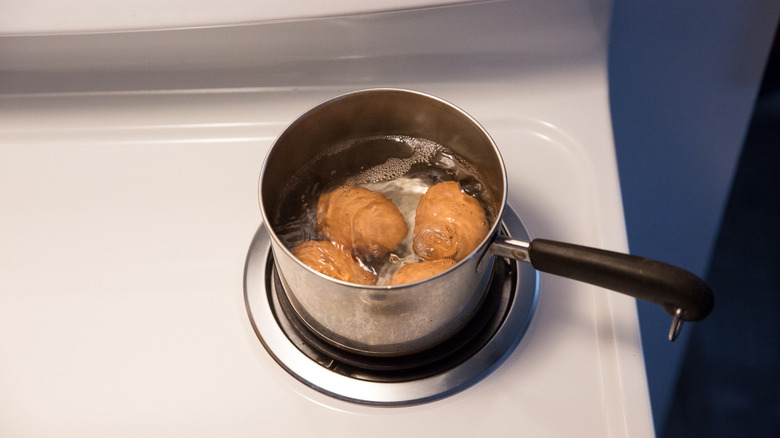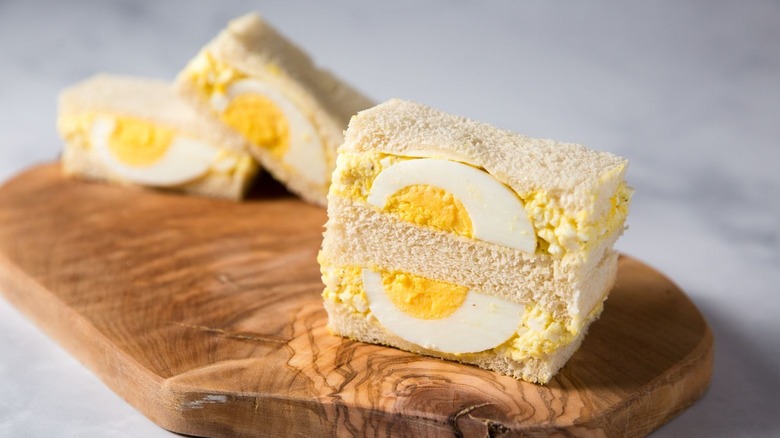Our Japanese Egg Sandwich Recipe Is A Balance Of Sweet And Savory
We may receive a commission on purchases made from links.
There are nearly countless variations of egg salad sandwiches out there, and a tamago sando is one that's particularly popular in Japan, especially in convenience stores like 7-11. This simple sandwich is made from creamy egg salad on soft and fluffy shokupan bread, a Japanese milky white bread. The egg salad's flavor is enhanced with Japanese Kewpie mayonnaise and an optional pinch of sugar, and the bread provides a subtly sweet, milky flavor and an irresistibly soft, light texture, like a pillow, which is enhanced when the crusts are cut off.
Recipe developer Michelle Bottalico has created a recipe for a Japanese egg sandwich that's creamy and delicious. Following the Japanese tradition, this recipe uses Kewpie mayonnaise, which is slightly tangy and has a richer flavor and darker color because it's made from egg yolks, and the bread is buttered first for extra flavor. Sweetness comes from the bread and (optional) sugar in the egg salad, so the result is a delectable balance of creamy richness and sweet and savory notes. While the eggs in the egg salad are hard boiled, a semi-soft boiled egg is used for garnish in this recipe, and it's revealed when the sandwich is sliced in half and served for an extra special display.
Gather your Japanese egg sandwich (tamago sando) ingredients
To kick off this recipe, you will first need four large eggs. This recipe includes directions for boiling the eggs, since both hard boiled eggs and a semi-soft boiled egg are used, but you can use store-bought, peeled hard boiled eggs to make the process more convenient, if desired.
You will also need Kewpie mayonnaise, but regular mayonnaise will work in a pinch. The best bread for this particular sandwich is Japanese shokupan bread, but any Pullman loaf of soft white sandwich bread can be substituted. Finally, the only other ingredients you'll need are salt, pepper, and unsalted butter.
Step 1: Cover eggs with water in pan
Place the eggs in a single layer in a medium saucepan. Fill the pan with water until the eggs are just covered.
Step 2: Heat the water and eggs
Transfer the saucepan to the stovetop, heating on medium-high until the water comes to a rolling boil.
Step 3: Remove pan from heat, cover, and set a timer
Boil for 30 seconds, then immediately remove the pan from the heat, cover it, and set a timer for 11 minutes.
Step 4: Prepare the ice baths
Meanwhile, fill one small and one large mixing bowl with cold water and ice.
Step 5: Remove an egg at the 6-minute mark
Remove 1 egg from the hot water after 6 minutes have elapsed and place it in the small ice bath. This is the semi-soft boiled egg that will be reserved for decorating the sandwiches.
Step 6: Finish cooking remaining eggs then transfer to ice bath
Remove the remaining 3 hard-boiled eggs after 11 minutes and place them in the larger ice bath.
Step 7: Peel the eggs
After the eggs have cooled completely, about 10 minutes, remove them from the ice baths and peel them, making sure to keep the semi-soft boiled egg separate.
Step 8: Mash the hard-boiled eggs
Place the 3 hard boiled eggs in a mixing bowl and mash them into small, even pieces with a fork.
Step 9: Add mayo, salt, pepper, and optional sugar to egg salad
Add the mayonnaise, salt, pepper, and a couple of optional pinches of sugar to the eggs and mix well. Taste and adjust for seasonings.
Step 10: Position the semi-soft boiled egg on bread slices
Cut the reserved egg in half lengthwise and place each half in the center of 2 pieces of bread, cut side-down.
Step 11: Add the egg salad
Spoon half of the egg salad around the egg on each piece of bread.
Step 12: Butter the bread
Butter the other 2 slices of bread and place them butter side-down over the egg salad.
Step 13: Cut off the crusts
Cut the crusts off the bread.
Step 14: Serve the Japanese egg sandwiches
Cut each sandwich in half and serve.
Pairs well with Japanese egg sandwiches
Japanese Egg Sandwich (Tamago Sando) Recipe
This Japanese egg sandwich, also called a tamago sando, features sweet, crustless Japanese milk bread and an umami-rich, Kewpie mayo-infused egg salad.

Ingredients
- 4 large eggs
- 3 tablespoons Kewpie mayonnaise
- ¼ teaspoon salt
- ⅛ teaspoon pepper
- 1 tablespoon unsalted butter, softened
- 4 slices soft white sandwich bread
Optional Ingredients
- Sugar, to taste
Directions
- Place the eggs in a single layer in a medium saucepan. Fill the pan with water until the eggs are just covered.
- Transfer the saucepan to the stovetop, heating on medium-high until the water comes to a rolling boil.
- Boil for 30 seconds, then immediately remove the pan from the heat, cover it, and set a timer for 11 minutes.
- Meanwhile, fill one small and one large mixing bowl with cold water and ice.
- Remove 1 egg from the hot water after 6 minutes have elapsed and place it in the small ice bath. This is the semi-soft boiled egg that will be reserved for decorating the sandwiches.
- Remove the remaining 3 hard-boiled eggs after 11 minutes and place them in the larger ice bath.
- After the eggs have cooled completely, about 10 minutes, remove them from the ice baths and peel them, making sure to keep the semi-soft boiled egg separate.
- Place the 3 hard boiled eggs in a mixing bowl and mash them into small, even pieces with a fork.
- Add the mayonnaise, salt, pepper, and a couple of optional pinches of sugar to the eggs and mix well. Taste and adjust for seasonings.
- Cut the reserved egg in half lengthwise and place each half in the center of 2 pieces of bread, cut side-down.
- Spoon half of the egg salad around the egg on each piece of bread.
- Butter the other 2 slices of bread and place them butter side-down over the egg salad.
- Cut the crusts off the bread.
- Cut each sandwich in half and serve.
Nutrition
| Calories per Serving | 503 |
| Total Fat | 34.6 g |
| Saturated Fat | 9.6 g |
| Trans Fat | 0.1 g |
| Cholesterol | 395.7 mg |
| Total Carbohydrates | 28.4 g |
| Dietary Fiber | 2.4 g |
| Total Sugars | 3.7 g |
| Sodium | 542.1 mg |
| Protein | 18.9 g |
What are tips for boiling eggs correctly?
Use fresh, pasteurized eggs for making soft boiled eggs to minimize the risks of consuming undercooked yolks. Older eggs are better for hard boiled eggs, on the other hand, because they will be drier and easier to peel. To boil eggs correctly, you'll first need a kitchen timer. It's important to measure the number of minutes for cooking eggs precisely in order to achieve the soft or hard boiling result your recipe indicates, since the appearance of the outside of the eggs won't change. Have an ice bath ready. Remove the eggs from the pan with a slotted spoon and submerge them in the icy water to stop the cooking once the time is up.
This recipe uses the hot water resting method, so place the eggs in a single, uncrowded layer in a saucepan and cover them with cool water until they're just submerged. Bring the water to a boil, let it boil for just 30 seconds, and them immediately remove it from the heat and cover the pan. Then it's a matter of setting the timer and waiting. Avoid overcooking eggs because they'll have rubbery whites, green yolks, and a sulfuric odor.
If you find hard boiled eggs hard to peel, add a little vinegar to the cooking water because it breaks down the shell a little. You can also crack them slightly when they're in the ice bath to allow cold water to enter the shell, which will make it easier to peel them.
What types of bread work best when making tamago sandos?
The most common bread used to make tamago sando in Japan is called shokupan, a Japanese milk bread with a long history. It is soft, white, and fluffy, with a milky, rich, and slightly sweet taste. Shokupan can be found in the United States at Japanese grocery stores or Asian groceries with a larger selection. Of course, you can also find recipes for shokupan online, should you want this sandwich to be completely from-scratch.
Shokupan is a type of Pullman loaf, which means it's baked in a loaf pan with straight sides and a flat lid on top, which prevents the top from becoming raised, curved, and split. The result is square slices with four straight sides. The Pullman loaf pan got its name from the Pullman railway system, and the Pullman company itself is credited with naming the pan because its easy-to-stack shape saved space in their train's dining cars.
The most economical substitution for this sandwich is any soft white sandwich bread that has the square, flat shape of a Pullman loaf, which can be found in the regular bread aisle of the grocery store. Use brioche bread for a tender texture and richer taste, although it's buttery, more strongly flavored, golden rather than white, and isn't square (though some crafty knife work could certainly get it to that more classic square shape).


















